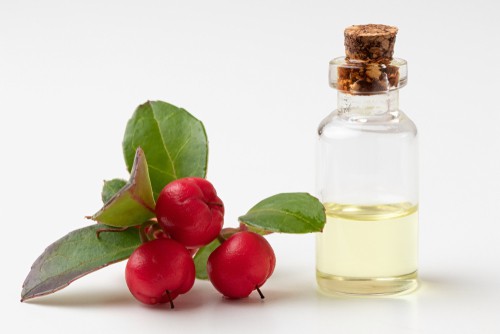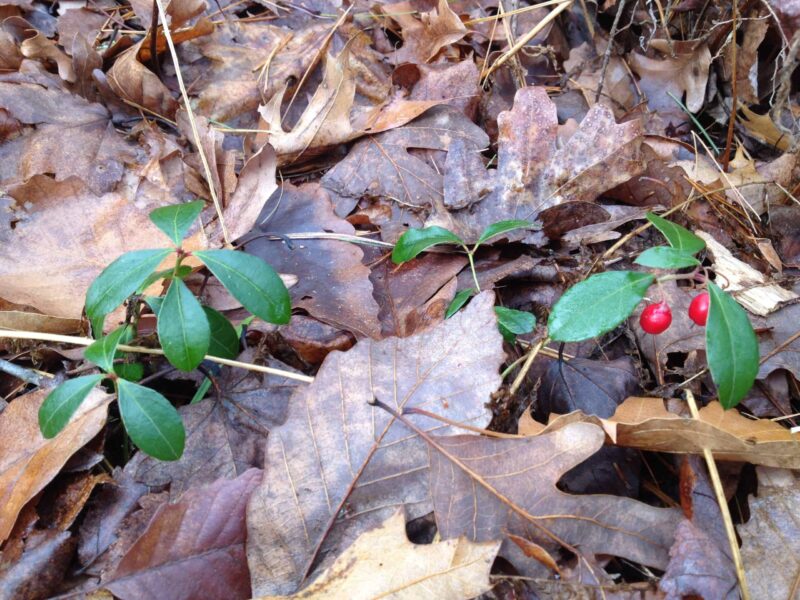Wintergreen plants grow low to the ground and cover forest floors. The striking red berries catch the eye of birds and hikers in the cold winter months. It isn’t common to find large patches of the berries all at once. Instead, most outdoor enthusiasts will only find a few they can gather in their palms along the way. With their attractive color and scent, many want to know if the plants are edible. Fortunately, these natural breath fresheners can be safely eaten by most people. Of course, like with any edible wild plants, hikers will want to be very sure that they know what they have and what is and isn’t safe for them to consume, so it’s important to be as well-educated on the plant as possible.
Are Wintergreen Berries Edible?
Yes, American wintergreen are edible berries for most of us.
There is one major exception that is important to keep in mind. If you have an allergy to Aspirin, you should avoid Wintergreen berries. That may sound surprising. The issue is that the entire plant has a high concentration of a natural Aspirin. The compound is in the oils of the plant and is most highly concentrated in the leaves. Someone with an Aspirin allergy is likely to have a bad reaction and should consider Wintergreen to be toxic berries.
For everyone else, this low-growing plant is a delightful find! The intense Wintergreen flavor of the red berries is immediately recognizable to anyone who has had wintergreen gum or candies throughout their childhood. When you find the plants in the wild, you can break the shiny wintergreen leaves and catch the strong and familiar scent.
Can I Eat Wintergreen Leaves?
Yes, the wintergreen leaves are edible. However, most people don’t enjoy just nibbling on the leaves as they are. The leaves are more commonly used to make herbal teas. As mentioned above, people with an Aspirin allergy should not eat the leaves.
The leaves lose their flavor pretty quickly after they’re picked. For this reason, the tea is best when it’s been steeped at low temperatures for a long time. People who enjoy wintergreen tea will often gather a few leaves to put into a jar, pour in warm water, and then leave it alone for anywhere from several hours to several days before drinking. The tea can be stored in the fridge and then warmed up before drinking.
Where To Find Wintergreen Berries
American Wintergreen is a low-growing plant found in the forests of Eastern North America. It’s common to find these native plants in New England and Eastern Canada. While it’s called a shrub, the term brings to mind a much larger plant than this actually is. Wintergreen usually only grows a few inches tall, with several glossy dark green leaves and only a couple of berries per plant. They happily grow in full shade or part shade in acidic soils. Hikers often eat them as breath fresheners on the trail, but they’re extremely lucky if they manage to find a handful all at once. You’ll most likely spot just a couple of berries at a time.
Hikers who frequent the same trails often will take note of where they spot these evergreen plants and return to them throughout the year for a fun little treat along their path.
When To Eat These Edible Wild Berries
American Wintergreen is an evergreen plant, so you’ll see the entire plant throughout the whole year. In late summer, these small shrubs will have white or pale pink flowers. The blooms look similar to blueberry flowers. Late in the summer, the flowers will become pale green berries. When they’re green, they’re not ripe yet. In late fall, those pale green berries will slowly turn into small, bright red berries. Usually, there are only two or three berries per plant.
The red berries will remain on the plant through the early winter, the first frost, and will stay looking bright and cheery against the snow during the winter months. However, especially during a cold winter, the berry will become more dried out as time goes on. While the berries can still hang on in early spring, they are likely to be less flavorful. Some people call Wintergreen berries mealy during the best of times, and that will be more true with any berries found in early summer.
The best time to eat these edible wild berries is in the late fall or early winter, when they’re at their most flavorful. Hikers can confirm they have Wintergreen by crushing the berries and then smelling them.
Be Careful Not To Mistake Wintergreen For These Two Common Wild Plants
Depending on where you are located, it can be easy to confuse these low-growing plants with a few others. Partridge berry looks very similar. This is a harmless example, since Partridge Berry is also evergreen with red berries and is also edible. The main difference that outdoor enthusiasts will be quick to notice is that Partridge lacks the Wintergreen flavor and scent. In fact, Partridge Berries are fairly tasteless.
There are two poisonous plants that appear similar but are actually poisonous. The first is Mountain Laurel. This plant is poisonous to humans and dogs. It’s a pretty plant that grows to be much taller than Wintergreen once it’s mature, but when it first sprouts up can sometimes be mistaken for Wintergreen.
The second is actually many varieties of poison ivy, which can also have shiny leaves and grow low to the ground.
Be sure to take a careful look at any wild plants before touching them, and definitely before eating them. It’s best to use two trusted sources to help you identify anything before you declare it safely edible.
Do Animals Eat Wintergreen Berries?
American Wintergreen isn’t a staple of many animals, but it is still a fairly important part of nature. The berries are a wild food source that animals can rely on in the cold winter months. The berries are most popular with birds, wild turkey in particular.
Do Wintergreen Plants Go By Other Names?
Wintergreen has several common names. It is true that wintergreen is perhaps the most common. In some areas, you’ll hear it referred to as teaberry or checkerberry. While they are used less often, you may also hear the terms Canada tea, eastern teaberry, mountain tea, boxberry, or deerberry, all referring to the wintergreen berries. The scientific name for the plant is Gaultheria procumbens.

Is Wintergreen Oil Made From Wintergreen Berries?
No, wintergreen essential oil is not made from wintergreen berries, but it is made from the plant. The glossy leaves are used to make wintergreen oil, which is also often called gaultheria oil. The “gaultheria” part of the name comes from the scientific name for wintergreen berries, gaultheria procumbens.
Wintergreen oil is made by distilling the plant until it becomes almost entirely methyl salicylate. Today, many companies prefer to use synthetic methyl salicylate instead of harvesting the plant, so the true essential oil is on the decline. While many report using wintergreen oil for inflammation and pain, there isn’t much in the way of scientific studies on the subject, and what there is has been mixed. This is true of most essential oils at this time.
Do Wintergreen Plants Have Medicinal Uses?
There aren’t many scientific studies that suggest Wintergreen plants have medicinal uses. However, the plant does naturally have methyl salicylate and salicylic acid, which are known to have medicinal uses.
Some people report that they have used Wintergreen oil for pain and inflammation.
Others have reported that drinking herbal teas made with wintergreen leaves has worked for pain and inflammation relief. There aren’t many reports of Native Americans historically using Wintergreen plants, but some reports do say that they historically used Wintergreen to make teas for pain relief.
How To Eat Wintergreen Plants
For the most part, the red Wintergreen berries are snapped up and eaten by experienced hikers only a couple of berries at a time, as a fun little treat while hiking along a new trail. Enthusiasts who wander the same paths and have learned to find stores of Wintergreen berries they can return to and collect the berries have a few more options.
With a good little handful of the berries, adding up to around two ounces, they can be used to make homemade minty ice cream. Most people will want to also add other flavorings, like chocolate chips.
A few more berries can be used as a flavoring for a wintergreen pie.
Some people will use the leaves to make a Wintergreen tea, as mentioned above, but don’t expect the tea to taste particularly strong. It will be a mild flavor as the Wintergreen leaves become less potent after they’re picked.
American Wintergreen Berries Are Enjoyable Breath Fresheners On The Trail
American Wintergreen is found across the Northern United States, particularly on the east coast, going up into Canada. The plant is low to the ground and easy to miss, except in the cold winter months where the red berries and dark green shiny leaves stand out against an inch or two of snow. The berries and leaves are safely edible for most people, but people with an Aspirin allergy will want to avoid the plant altogether. Mostly, Wintergreen plants are known for being beautiful and for their commercial use as the inspiration for artificial flavoring in candies and chewing gums. Experienced hikers will enjoy a berry or two as a palette cleanser when they’re spotted growing alongside trails.
Recent Posts
The only venomous snakes in Washington State are Northern Pacific Rattlesnakes. The Northern Pacific Rattlesnake (Crotalus oreganus oreganus) is a sub-species of the Western Rattlesnake. Anyone...
Skunks are not classified as true hibernators. But they go into a state of torpor when the weather gets cold. Skunks are light sleep hibernators, along with opossums, bears, and raccoons. ...

